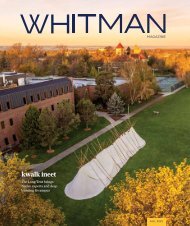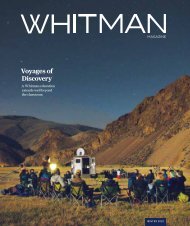Whitman College Undergraduate Conference Program 2020
Whitman College 2020 Undergraduate Conference Program
Whitman College 2020 Undergraduate Conference Program
Create successful ePaper yourself
Turn your PDF publications into a flip-book with our unique Google optimized e-Paper software.
Poster Session<br />
1 - 3 p.m., Cordiner Hall<br />
MOSES BARTON, LOUIS MOENCH, Identification of a Key<br />
Structure in Morphological Development of Neurons<br />
Neurons, the cells of the brain, perform their normal functions<br />
through connections between each other. The process of<br />
growing connections is associated with learning, memory and<br />
general cognitive ability and is implicated as an important<br />
factor in understanding neurological disorders related to<br />
these processes. Examining videos of neurons growing in<br />
culture, we observed a structure called a lamellipodium whose<br />
appearance was associated with growth and branching. We<br />
hypothesized that this structure was a precursor to neuronal<br />
branches and predicted that it would appear at sites of future<br />
branch formation. We developed working definitions for other<br />
morphological features that also appeared to be associated<br />
with the branching process and tested whether there was<br />
a predictable sequence of events that could predict a new<br />
neuronal branch. Quantification showed that 98% of the time,<br />
new branches were preceded by lamellipodia, suggesting this<br />
could be an essential intermediate step in branch formation.<br />
Faculty Sponsor: Ginger Withers<br />
ESTELLA BASTIAN, Terazosin and Pgk1: Enhancing Enzyme<br />
Activity to Reduce Mitochondrial Dysfunction and Cell Death in<br />
Neurodegeneration<br />
Energy impairment and oxidative stress are fundamental<br />
agents involved in the pathology of many diseases including<br />
Parkinson’s, a neurodegenerative disease characterized by the<br />
loss of dopaminergic neurons. High levels of oxidative stress can<br />
lead to mitochondrial energy failure and ultimately cell death.<br />
Developing a therapeutic strategy that can augment glycolysis<br />
may counteract mitochondrial dysfunction and therefore prevent<br />
neuronal death. Terazosin, a widely used hypertension drug,<br />
was found to activate Pgk1, a key energy-generating enzyme<br />
in glycolysis. By activating Pgk1 and therefore increasing<br />
mitochondrial energy production, terazosin is able to prevent<br />
neuronal cell death in animal models. I performed an in vitro<br />
assay to investigate Pgk1’s activity under the presence of<br />
potential activators that closely resemble terazosin in structure.<br />
Current therapies for Parkinson’s treat symptoms, but terazosin<br />
may be the first to prevent the disease’s progression.<br />
Faculty Sponsor: Michael Coronado<br />
JAMES BENT, 1 H-qNMR Analysis Reveals New Trends in Substrate<br />
Specificity of Benzoate Dioxygenase in Ralstonia eutropha B9<br />
Biocatalysis leverages the power of enzymes to carry out<br />
complex reactions that can provide novel approaches to the<br />
synthesis of chiral molecules. Ralstonia eutropha B9 is a<br />
mutant soil bacterium that expresses benzoate dioxygenase<br />
(BZDO). BZDO specializes in the cis-dihydroxylation of<br />
benzoate at the 1,2 position as the first step in its metabolic<br />
degradation. The metabolites derived from this transformation<br />
have proven to be excellent chiral precursors for the synthesis<br />
of epoxyquinoid natural products, compounds which<br />
have been shown to be potent inhibitors of angiogenesis.<br />
My research uses quantitative proton nuclear magnetic<br />
resonance ( 1 H-qNMR) to characterize the activity of BZDO on<br />
new substrates of this enzyme system, allowing us to draw<br />
new conclusions concerning the effects of size and electronwithdrawing<br />
character on the rate of metabolic activity.<br />
Faculty Sponsor: Jon Collins<br />
MATT BIHRLE, The Plankton Paradox: Drivers of Phytoplankton<br />
Biodiversity Off the Coast of New Zealand<br />
Phytoplankton present an ecological paradox. It is<br />
generally believed that when two species compete for the<br />
same resources one will be driven to extinction. However,<br />
aqueous environments are able to support diverse plankton<br />
populations while each species is competing for the same<br />
resources in the same environment. My study aimed to<br />
discover which environmental variable or combination<br />
of variables are the most important in influencing<br />
phytoplankton diversity across unique environments off<br />
the northeastern coast of New Zealand. Using multivariate<br />
analysis, I found that fluorescence, a proxy for wholecommunity<br />
productivity, is most closely correlated with<br />
diversity by genus. This finding emphasizes that community<br />
membership is dependent upon what other species are<br />
present rather than environmental variables alone. Just as in<br />
macro-communities, these microscopic communities depend<br />
heavily on interspecies relationships to maintain biodiversity.<br />
Faculty Sponsor: Arielle Cooley<br />
ZANE BOYER, Chemoenzymatic Synthesis of Epoxyquinoid<br />
Natural Products<br />
Epoxyquinol A is a representative member of a group of<br />
naturally produced compounds known as epoxyquinoids.<br />
These compounds display a broad range of biological<br />
functions, including inhibition of angiogenesis (growth<br />
of new blood vessels). Angiogenesis has been linked to a<br />
number of disease states, including cancers, arthritis and<br />
inflammation. I present a novel chemoenzymatic approach<br />
to the synthesis of epoxyquinol A and related compounds.<br />
My ultimate goal is to develop the synthesis of a suite of<br />
compounds so that their biological activities may be explored.<br />
Faculty Sponsor: Jon Collins<br />
JESSICA BOYERS, Location of DDT on Sediment Particles<br />
DDT (dichlorodiphenyltrichloroethane) was used in the mid-<br />
20th century as a common and popular insecticide. In the<br />
1970s it became regulated due to its negative environmental<br />
effects on wildlife and as a probable human carcinogen.<br />
8 9

















